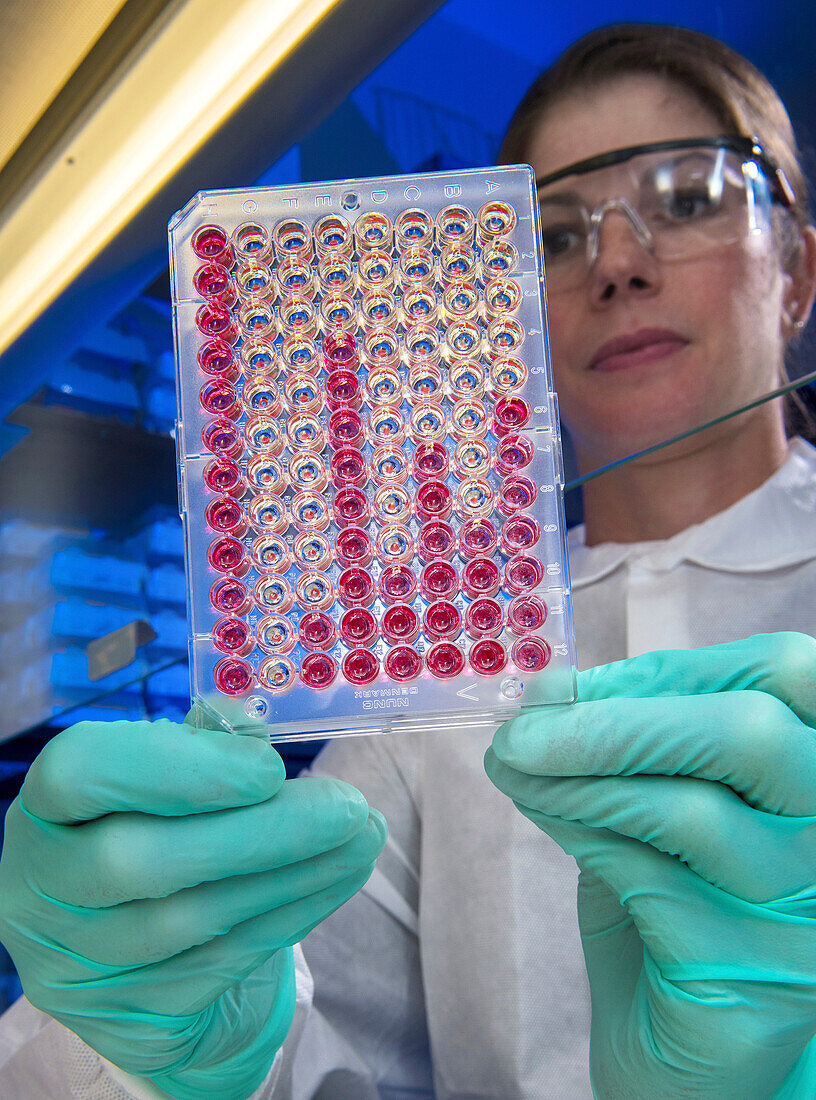Scientist examining results of haemagglutinin inhibition test
Bildnummer 14232383

| Scientist examining a microtiter plate showing the results of a haemagglutinin inhibition (HI) test, which is used to characterise proteins known as antigens which are found on the surface of viruses. Haemagglutinin (HA) is an antigen found on the surface of influenza (family Orthomyxoviridae) viruses. HA can bind red blood cells in a process called haemagglutination, causing them to form lattices, shown by wells which have gone fully red. HI tests work by adding antibodies (type of protein) which bind to HA, inhibiting the process of haemagglutination. Small red dots indicate where this inhibition has occurred. If one type of antibody inhibits HA in several strains of influenza (indicated by multiple small red dots), it suggests these strains of influenza have similar antigens. | |
| Lizenzart: | Lizenzpflichtig |
| Credit: | Science Photo Library / James Gathany, Robert Denty, CDC |
| Bildgröße: | 2670 px × 3600 px |
| Modell-Rechte: | Derzeit liegt noch kein Release vor. Bitte kontaktieren Sie uns vor Verwendung. |
| Eigentums-Rechte: | nicht erforderlich |
| Restrictions: |
|
Preise für dieses Bild ab 15 €
Universitäten & Organisationen
(Informationsmaterial Digital, Informationsmaterial Print, Lehrmaterial Digital etc.)
ab 15 €
Redaktionell
(Bücher, Bücher: Sach- und Fachliteratur, Digitale Medien (redaktionell) etc.)
ab 30 €
Werbung
(Anzeigen, Aussenwerbung, Digitale Medien, Fernsehwerbung, Karten, Werbemittel, Zeitschriften etc.)
ab 55 €
Handelsprodukte
(bedruckte Textilie, Kalender, Postkarte, Grußkarte, Verpackung etc.)
ab 75 €
Pauschalpreise
Rechtepakete für die unbeschränkte Bildnutzung in Print oder Online
ab 495 €
Keywords
- Antikörper,
- Begutachten,
- Biochemie,
- biochemisch,
- Biologie,
- biologisch,
- eine Person,
- Erythrozyten,
- Experiment,
- Frau,
- Gesundheitswesen,
- Halten,
- Hämagglutinin,
- Handschuhe,
- Immunologie,
- immunologisch,
- Impfstoff,
- kaukasisch,
- Lesen,
- ppe,
- rote Blutkörperchen,
- Schutzbrille,
- Tablett,
- Teller,
- Test,
- Testen,
- Virologie,
- virologisch,
- Weiblich,
- weiß,
- weißer Hintergrund,
- Wissenschaftler
